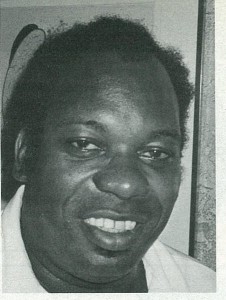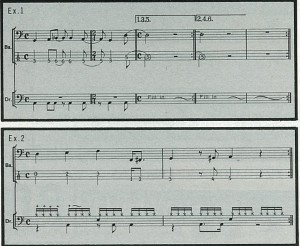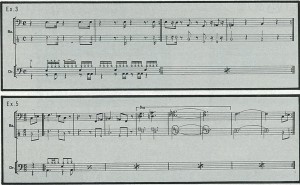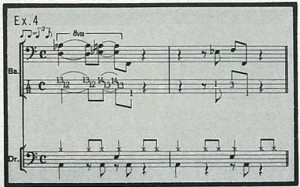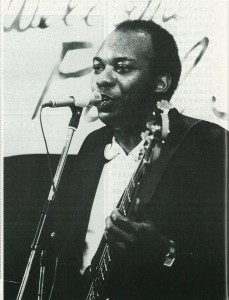From November, 1986 issue of Bass Magazine
Translation of Musician’s Special Seminar
What Time Is it!? By Paul Jackson
Series No.2: HOW TO TRAIN YOUR DRUMMER
Japanese bands are wonderful, but they need to strengthen bass line.
Nice to meet you again! I’m Paul Jackson. Did you understand my seminar in the previous edition? This time, as a succession to the previous seminar, I will take up the theme “how to train your drummer”. First, let me explain what this theme means.
“Training your drummer” may sound like a bassist being superior to drummer, which is not true. This is about how a bassist should play with a drummer. Then, why do I phrase the theme like “how to train your drummer”? This has something to do with the fact that a bassist must function as guide to other instrument players in various aspects of a song. In other words, you, the bassist should know how to guide your drummer. Of course, it might happen that I follow a drummer’s guidance. However, what I want to teach here is, when a bassist is in a position to be followed by a drummer, what can he do to make it smooth?
Try playing “repeat and repeat” if you want to get hold of a ticket for the unknown.
When you try playing with a drummer, you should find some suitable sample music. Blues or Latin are recommended. Either way, playing lines are simple, but they are rather difficult if you want to play them well. You play these lines over and over. Repeating is very important. This is true especially for beginners, who need to obtain the feeling of groove by repeating certain lines over and over. This is very important in order to learn the correct rhythm feeling. It might be an idea to play with rhythm machine if you are a real beginner. If you must practice all by yourself, please use at least a metronome.
What you must do when you play with a drummer is to leave “space” in between lines. By doing so, a bassist can direct a drummer. Please look at Example 1. The Bass line in the 3rd bar is only a note stretched from the 2nd bar. This is the same for the 4th and 5th bars. These parts show what I meant by “space”. A drummer will insert “fill” here. A Bass line with space in it can encourage a drummer to insert a “fill”. Moreover, when a bassist repeats this at odd-numbered or even- numbered times, a drummer is required to come up with space of different length respectively. Playing bass with lines like this means that a bassist is leading a drummer. A drummer, in the meantime, tries to understand the bass line you play, and tries to pick up space on his own, which makes the whole thing more musical.
If a bassist is still a beginner, he may not be able to play good phrases. If you can play a phrase where only eighth notes are laid out in sequence, try to have space somewhere in one phrase. If you think of some more difficult phrase, just repeat it over and over. It doesn’t matter if you make a mistake in playing it. If you make a mistake, just repeat the phrase as you made a mistake. You might play it wrong once and people think it a mistake. But surprisingly, if you repeat the mistake, these mistakes are not considered mistakes. A new good phrase can be borne out of it. I call this “a ticket for the unknown”. If anything is unknown, even when you feel it may not be right, keep on playing it. If you play it more than two times, you are bound to find something. Of course, there are some mistakes, which are just mistakes, and from which nothing is born. Even such a mistake may simply not fit the pattern you are playing now, and it might be a pattern which might fit on some other occasion. Even such a phrase may be forgotten if you play it only once, but you won’t forget it if you play it over and over.
This is a process in which you work with Call and Response freely.
Relating to this, “Call and Response” is important. Once you understand to play with some space, you can give out a Call to a drummer, or give out a Response to a drummer’s call. A bassist and a drummer must talk to each other (of course using their respective instruments) Practically,this is something like, listening to certain music, and deciding between you and a drummer to play something similar. You and your drummer can listen to the same music, and agree with each other to play, say, this funk music, for instance. Then you two just listen to the music very well and practice it. Try playing different types of music; Funk, Latin, Rock. Always make efforts so that you play some new patterns. Push each other between you and a drummer, so that your relationship is always fresh.
As you and your drummer practice like the above, you two will find you are making improvement in timing and feeling. The next thing to do between you two is to play counter rhythm. A bassist and a drummer seem to be playing two different rhythms, but when the timing of the two playing meets, a new rhythm is created by each player’s playing together. You can practice this by following Example 2 through Example 5, or making something similar. Alternatively, when a drummer plays in four-four time, and a bassist plays in five-four time. In this case, the two play together , every 20 beats.
A bassist sometimes must have courage to play off road, rhythmically speaking. Musicians around the bass player might be surprised, but as long as a bassist comes back on road later, it is no problem. If you are careful to play correctly, you end up just maintaining the present. It can be a real plus when you make a big detour and find out your co-players’ reactions to it.




